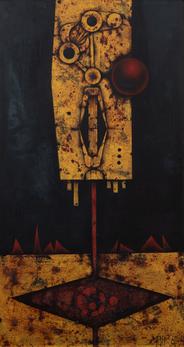Lot #147

Mikuláš Medek (1926–1974)
Gold Cry II
Estimate: 7,000,000 CZK – 10,000,000 CZK
Starting price: 6,000,000 CZK
6,000,000 CZK
Gold Cry II was created during a short period of time when Medek was both at the height of his international renown and on the eve of Normalisation, which would drive him into isolation. It is the second in a series of three works titled Gold Cry (I dating from 1968, II and III from 1969), in which the artist developed the cry as a motif that would go on to become a major means of expression for him after 1967. The verticality of the canvas seems to envelop the viewer in a claustrophobic feeling. A golden, oblong monster, composed of dense, torn matter and mechanical components designed for destruction, expands in the darkness and embeds itself, via a crimson rhomboid filled with glowing hotspots, into a golden substrate, as if opening a mouth to the interior of its body. In the elements that create the body of the crying entity – teeth, beaks, mouths, strings, spheres, cells, thorns traumatically penetrating matter – we see moments of material damage, along with hints of sexual iconography and metaphors of self-flagellation in the shape of a beast devouring itself. Medek achieved an impressive dialectic between the internal tension and the destruction of the external surface. The golden tonality enters into sharp confrontation with the red accents and monumental black that surrounds everything. The artist made no compromises; everything has been escalated to the edge of what is bearable. The rediscovery of this canvas affords a rare opportunity to see Medek’s excellent technical command of enamel and oil and his success in reshaping personal trauma into a masterful artistic message. The cry here is not merely an expression of existential anxiety, but takes on a new dimension of impending catastrophe – which subsequently occurred during the Normalisation years of the 1970s. The painter’s technical virtuosity in creating the sculptural structure of the painting’s surface documents his skill in transforming traumatic experience into an independent artistic testimony. Gold Cry II thus represents a synthesis of Medek’s lifelong battle with the substance of painting and the historical events that predetermined his artistic fate and culminated in the cycles Thirsty Angels and Moving Graves. The work has been presented in exhibitions: 25. Salon de Mai, 12 May – 1 June 1969, Salles d’exposition Wilson, Paris, cat. no. 132; Mikuláš Medek, Emila Medková, Galerie am Klosterstern, Hamburg, March 1970; and Mikulás Medek, Prag, Kunstkreis Leinfelden, 8–24 May 1970. It originates from a high-quality Czech collection. The work will be included in the upcoming inventory of the artist’s works by PhDr. E. Kosáková-Medková. The painting was assessed in consultation with Professor J. Zemina and PhDr. E. Kosáková-Medková, an art historian and the artist’s daughter. The expert opinion of PhDr. K. Srp is attached: “[...] The symmetric Gold Cry is the sum of [Medek’s] expressive motifs, stacked side by side and in development from 1967. [...] The painting Gold Cry II is a revelation: it has not been exhibited for a long time, and viewers can observe Medek’s very subtle interventions in geometric shapes, the most striking of which is the left edge, which is slightly bevelled, as if its shape had been made by the intervention of the red sphere. [...].”




